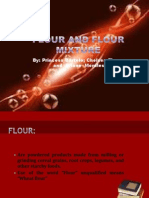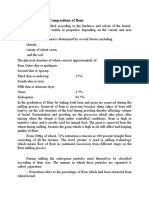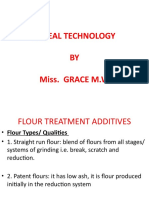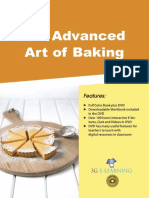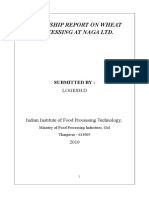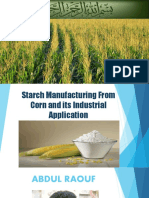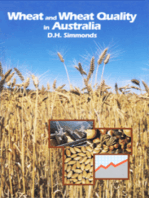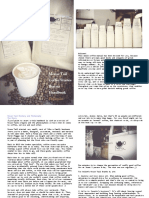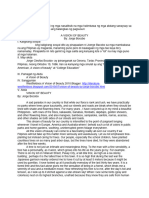Quality Criteria and Tests: Milling Wheat
Quality Criteria and Tests: Milling Wheat
Uploaded by
ravivarmahyd8173Copyright:
Available Formats
Quality Criteria and Tests: Milling Wheat
Quality Criteria and Tests: Milling Wheat
Uploaded by
ravivarmahyd8173Original Description:
Original Title
Copyright
Available Formats
Share this document
Did you find this document useful?
Is this content inappropriate?
Copyright:
Available Formats
Quality Criteria and Tests: Milling Wheat
Quality Criteria and Tests: Milling Wheat
Uploaded by
ravivarmahyd8173Copyright:
Available Formats
6
Moisture content
Wheat quality is threatened when the moisture
content of stored grain exceeds 15%.There is a
risk of infestation and mould as well as
mycotoxin formation,all of which can lead to
rejection.
Specific weight
Thin,shrivelled grain will not mill to produce
adequate amounts of clean,white flour.
The specific weight test measures the weight of
grain in kilogrammes that can be packed
into a cylinder of fixed volume,normally 1 litre,
and indicates grain filling.
Screenings and admixture
Screenings are undersized grains and admixture
comprises impurities,eg chaff, weed seeds and
earth,which must be removed before milling
marketable flour. Screenings and admixture
represent a loss to the miller, so a maximum of
2%is normally allowed.
Screenings and admixture are measured using
standard slotted 3.5 mm and 2 mm sieves.
Variety
Wheat varieties are categorised by nabim
Groups 1 to 4.Groups 1 and 2 are used for
most breadmaking grists while Group 3 is used
for a range of biscuit,cake and batter flours.
Protein content
P rotein content is specified for all bake ry fl o u rs
and is a key part of the contra c t . For most
b readmaking fl o u r, wheat with a protein content
ab ove 13%dry matter, is pre fe rre d . If pro t e i n
content cannot be ach i eved using home-grow n
w h e a t ,i m p o rted high protein wheat or wheat
gluten can be added in. For most biscuits and
c a ke s , gluten fo rmation is not re q u i red and
mu ch lower protein fl o u rs may be used.
Protein quality
When wetted,during dough making,some of
the proteins in wheat flour form a visco-elastic
substance gluten.This can hold gas produced
during fermentation and supports the starch
and bran producing a typical well-risen UK loaf.
The amount and quality of gluten produced
indicates potential performance.No fixed
threshold exists.
Milling wheat
quality criteria and tests
While almost any wheat can
be milled, millers produce a
wide range of flours with
specifications tightly defined by
bakers for each product.
Millers analyse and then
segregate each batch of wheat
to meet the quality their
customers require for each
grist or blend.
Need more information?
7
Hagberg Falling Number
Low Hagberg indicates high enzyme activity
and onset of sprouting. A threshold of 250
seconds is used for breadmaking wheat and
samples with low Hagberg are rejected.Low
Hagberg wheat produces bread with a dark
crust colour and a weak,sticky crumb that
cannot be sliced.
The Hagberg test is used world-
wide.It measures the time,
in seconds,a plunger takes
to descend through a
heated mixture of ground
grain and water.The test
provides an indirect
estimate of alpha-
amylase activity.
Moulds,damaged grain
and odours
Visual examination assesses grain for moulds,
Fusarium (pink grains) and particularly ergot.
Checks are made for live insects and grain
damaged by insects.
Experienced staff also assess grain for unusual
odours.Mustinessor chemicalodours
indicate storage problems.
Individual companies set their own criteria for
these assessments.
Grain hardness
Grain hardness is a key variety trait for milling.
Hard and soft wheats have different processing
requirements and end-uses.The hard wheats
used for breadmaking must absorb sufficient
water during dough making.Soft wheats are
preferred for biscuits as much added liquid is
baked out to produce a crisp product.
By crushing individual grains within a Single
Kernel Characterisation System (SKCS)
instrument,the miller can check grain hardness
and identify mixtures of hard and soft varieties.
Near infrared calibrations,based on SKCS,can
rapidly separate hard and soft wheat samples.
Important parameters
Ch ar act er i s t i c Far mer t es t I n t ak e t es t Buyer r es p on s e
Moisture content yes yes price deduction or rejection
Specific weight yes yes price deduction or rejection
Screenings and admixture yes yes price deduction
Variety no yes price deduction or rejection
Protein quality no yes price deduction or rejection
Protein content sometimes yes rejection
Hagberg Falling Number sometimes yes price deduction or rejection
for breadmaking
Moulds, damaged grain no yes price deduction or rejection
and odours
Grain hardness sometimes yes price deduction or rejection
Visit the nabim website at www.nabim.org.uk
You might also like
- Asta Analytical MethodsDocument4 pagesAsta Analytical Methodsravivarmahyd8173No ratings yet
- Flour Mills SafetyDocument49 pagesFlour Mills SafetyKriston Edward100% (7)
- NSTP-Narrative-Report-suggestion 2Document10 pagesNSTP-Narrative-Report-suggestion 2Marissa Cordova100% (5)
- Sugar Prac 2 and 3Document18 pagesSugar Prac 2 and 3Ian FredrickNo ratings yet
- Cereal Labs AqibDocument35 pagesCereal Labs Aqibsalmanamjad995No ratings yet
- Assignment:-: Analysis of FlourDocument23 pagesAssignment:-: Analysis of FlourMuhammad FaizanNo ratings yet
- Artisan Bread Flour Quality & FormulationDocument8 pagesArtisan Bread Flour Quality & FormulationAshif MahmudNo ratings yet
- Processing Technology of Cereals ASFE 2201: Sudipta Behera Assistant Professor, SoabeDocument25 pagesProcessing Technology of Cereals ASFE 2201: Sudipta Behera Assistant Professor, SoabechtanmayeeNo ratings yet
- CH 2 Cereal GrainsDocument82 pagesCH 2 Cereal GrainsshahidNo ratings yet
- Flour and Flour MixtureDocument34 pagesFlour and Flour MixtureChelsea FloresNo ratings yet
- Quality Factors in Malting Barley - May 2010Document2 pagesQuality Factors in Malting Barley - May 2010Alberto LeaoNo ratings yet
- Bread ProductionDocument50 pagesBread ProductionQuoc KhanhNo ratings yet
- Sliced Bread: The Science ofDocument4 pagesSliced Bread: The Science ofGayatri PrameswariNo ratings yet
- Mbio313 Assignment 01 181-025-031Document7 pagesMbio313 Assignment 01 181-025-031Razia UrmiNo ratings yet
- Wheat To BreadDocument2 pagesWheat To BreadDevidas R AnantwarNo ratings yet
- Ignou PGDFT Notes On WheatDocument83 pagesIgnou PGDFT Notes On WheatPreeti Joshi Sachdeva100% (1)
- Food and Drug Analysis: Analysis of Wheat FlourDocument33 pagesFood and Drug Analysis: Analysis of Wheat FlourMuhammad JavaidNo ratings yet
- Barley Flour Mill DPR by NIFTEMDocument28 pagesBarley Flour Mill DPR by NIFTEMManav AggarwalNo ratings yet
- Barley Flour Mill DPR by NIFTEMDocument28 pagesBarley Flour Mill DPR by NIFTEMManav AggarwalNo ratings yet
- Technology OF Wheat Milling: Nimisha K OST-2015-24-13 M.Sc. FS&TDocument32 pagesTechnology OF Wheat Milling: Nimisha K OST-2015-24-13 M.Sc. FS&Traja singam100% (1)
- G1 - Crop Processing IntroductionDocument55 pagesG1 - Crop Processing IntroductionRichelle EspinedaNo ratings yet
- Wheat MillingDocument6 pagesWheat MillingNaqiyuddin EhwalNo ratings yet
- Technical Dossier: Refined Millet FlourDocument20 pagesTechnical Dossier: Refined Millet FlourramanaNo ratings yet
- Three Distinct Parts: The KernelDocument22 pagesThree Distinct Parts: The Kernelzeeshan farooqNo ratings yet
- Method Brochure enDocument6 pagesMethod Brochure eng3lu06No ratings yet
- PlantFoods ISSUE 14 Wheat, Flour, BreadDocument3 pagesPlantFoods ISSUE 14 Wheat, Flour, Breadelina18202No ratings yet
- Cereals: - : IntroductionDocument8 pagesCereals: - : IntroductionAmit Kr Godara100% (1)
- Composition of FlourDocument7 pagesComposition of Flourगौ रव कृष्ण100% (1)
- Microbiological Production of Foods Baker's YeastDocument21 pagesMicrobiological Production of Foods Baker's YeastMd. Babul AktarNo ratings yet
- Note 2-FST 405Document9 pagesNote 2-FST 405Paul FavourNo ratings yet
- Wheat and Roots - 062116Document9 pagesWheat and Roots - 062116Jean MagbanuaNo ratings yet
- Abu 308 2024 IiDocument66 pagesAbu 308 2024 Iihedidorjustice58No ratings yet
- Ingredients & FunctionsDocument57 pagesIngredients & FunctionsRahman RamlanNo ratings yet
- Cereal Technology NotesDocument45 pagesCereal Technology Notesgrace mwenjeNo ratings yet
- Fluir SpecificationDocument13 pagesFluir SpecificationPaulo De Tarso CarvalhoNo ratings yet
- Chapter 2Document31 pagesChapter 2Ann Kulittt100% (1)
- YeastDocument43 pagesYeastResna N K Resi100% (1)
- Supply Chain Management of BreadDocument13 pagesSupply Chain Management of BreadSuzan Mady80% (10)
- Milling of CornDocument16 pagesMilling of Cornwasiraaj91No ratings yet
- Internship Report On Wheat Processing at Naga LTD.: Logesh.DDocument16 pagesInternship Report On Wheat Processing at Naga LTD.: Logesh.Dlogesh dhanapalNo ratings yet
- Wheat BookDocument13 pagesWheat BookAnonymous XybLZfNo ratings yet
- Fractionation and Reconstitution ofDocument125 pagesFractionation and Reconstitution ofNawal RaiNo ratings yet
- Unit 2 Wheat GrainDocument22 pagesUnit 2 Wheat GrainSHARMA TECHNo ratings yet
- BAKERpedia Pocket Guide Baking Gluten FreeDocument26 pagesBAKERpedia Pocket Guide Baking Gluten FreeiyerpadmaNo ratings yet
- ExtrusionDocument25 pagesExtrusionpankti100% (1)
- Falling NumbDocument11 pagesFalling NumbNaveenNo ratings yet
- Corn Starchmanufacturing 170416190429 PDFDocument51 pagesCorn Starchmanufacturing 170416190429 PDFAjay Sharma100% (1)
- Baking IngredientsDocument44 pagesBaking Ingredientsalvin manalaysayNo ratings yet
- Specific Occupancy Guidelines - GAP.17.23.3.1Document8 pagesSpecific Occupancy Guidelines - GAP.17.23.3.1Yoyon HaryonoNo ratings yet
- IntroductionDocument10 pagesIntroductionkerengmogotsi57No ratings yet
- Processing of Cereal GrainsDocument43 pagesProcessing of Cereal GrainsSagar ShahNo ratings yet
- CORN Processing Write-UpDocument12 pagesCORN Processing Write-UpHarbaaz SinghNo ratings yet
- Corn MillingDocument13 pagesCorn MillingMrudula MujumdarNo ratings yet
- International Starch Institute: TM 18-5www - ISI Technical Memorandum On Production of Corn StarchDocument7 pagesInternational Starch Institute: TM 18-5www - ISI Technical Memorandum On Production of Corn StarchArun ChaudharyNo ratings yet
- Flour and Flour Mixture: Group 2Document68 pagesFlour and Flour Mixture: Group 2PHAMAE JOY MEMBREVENo ratings yet
- Quality Factors in Malting BarleyDocument3 pagesQuality Factors in Malting BarleyTruong Anh TuanNo ratings yet
- Topic 6Document13 pagesTopic 6Faith GregorioNo ratings yet
- Industrial BiochemistryDocument17 pagesIndustrial BiochemistryMinahil AtharNo ratings yet
- Bread and Mother Yeast: 70 Recipes With Sourdough to Make Bread, Pizza, Focaccia and Desserts!From EverandBread and Mother Yeast: 70 Recipes With Sourdough to Make Bread, Pizza, Focaccia and Desserts!No ratings yet
- Questions on Barley, Malting and Malt in the Beer Brewing ProcessFrom EverandQuestions on Barley, Malting and Malt in the Beer Brewing ProcessRating: 4 out of 5 stars4/5 (1)
- Cap As Aici NoidsDocument1 pageCap As Aici Noidsravivarmahyd8173No ratings yet
- CBN Poppy Importers PN-PS-06-2022Document15 pagesCBN Poppy Importers PN-PS-06-2022ravivarmahyd8173No ratings yet
- Spice List 20121Document2 pagesSpice List 20121ravivarmahyd8173No ratings yet
- Boiling: Cashew Process Flow Chat Relevant MachineryDocument1 pageBoiling: Cashew Process Flow Chat Relevant Machineryravivarmahyd8173No ratings yet
- Contract Farming DatabaseDocument2 pagesContract Farming Databaseravivarmahyd8173No ratings yet
- Developmental Plan Template: Short Term ObjectivesDocument3 pagesDevelopmental Plan Template: Short Term Objectivesravivarmahyd8173No ratings yet
- EAP Reading Worksheet Week 4 - Happy PlanetDocument3 pagesEAP Reading Worksheet Week 4 - Happy PlanetPhương ThảoNo ratings yet
- Energy and Sustainable Development in NigeriaDocument36 pagesEnergy and Sustainable Development in NigeriaLambert Dafom NuhuNo ratings yet
- Planning With ContoursDocument5 pagesPlanning With ContourspurvabhagtNo ratings yet
- Working Papers in Value Added TaxDocument20 pagesWorking Papers in Value Added TaxLucy HeartfiliaNo ratings yet
- 03 PhilippinesDocument13 pages03 PhilippinesHenry TiredNo ratings yet
- GreenLane Donegal 2015Document25 pagesGreenLane Donegal 2015GreenlaneDonegalNo ratings yet
- 1 Introduction To IrrigationDocument22 pages1 Introduction To IrrigationArus JoshiNo ratings yet
- FloraExpo 2020 CatalogueDocument6 pagesFloraExpo 2020 CatalogueSN Sahu100% (1)
- Reino MerinaDocument21 pagesReino MerinaBruno AquinoNo ratings yet
- 5126 w04 QP 1Document20 pages5126 w04 QP 1mstudy123456No ratings yet
- Upsc Geography Syllabus PDF d2d714c8Document7 pagesUpsc Geography Syllabus PDF d2d714c8Saith DanishNo ratings yet
- Lolo Cevicheria MenuDocument2 pagesLolo Cevicheria MenuRose GarrettNo ratings yet
- EcologyDocument84 pagesEcologyfugicotorraNo ratings yet
- Length of Cotton FiberDocument2 pagesLength of Cotton Fiberishajain11No ratings yet
- Barista Guide PDFDocument12 pagesBarista Guide PDFAnonymous 8nT7fLhNo ratings yet
- Development Economics Vaidehi Ruparelia AU1811190Document7 pagesDevelopment Economics Vaidehi Ruparelia AU1811190Vaidehi RupareliaNo ratings yet
- Agricultural Programs To Help Marginalized Farmers in The PhilippinesDocument1 pageAgricultural Programs To Help Marginalized Farmers in The PhilippinesRae SlaughterNo ratings yet
- Panahon NG AmerikanoDocument2 pagesPanahon NG AmerikanoNadnad DomingoNo ratings yet
- Claas Jaguar 25 500 MM Forage HarvesterDocument3 pagesClaas Jaguar 25 500 MM Forage HarvesterGanesh SainavarapuNo ratings yet
- Feudalism and Manor SystemDocument30 pagesFeudalism and Manor SysteminsightsxNo ratings yet
- Traditional Plant Foods of Canadian Indigenous Peoples: Nutrition, Botany and UseDocument533 pagesTraditional Plant Foods of Canadian Indigenous Peoples: Nutrition, Botany and UseDan100% (5)
- Thời Gian Làm Bài 150 Phút, Không Kể Thời Gian Giao ĐềDocument5 pagesThời Gian Làm Bài 150 Phút, Không Kể Thời Gian Giao ĐềPluvi OphileNo ratings yet
- Emscher Park 1Document3 pagesEmscher Park 1Sorana PaleuNo ratings yet
- Mock Test 22Document4 pagesMock Test 22nguyendanthanh10No ratings yet
- International Starch Institute: TM 18-5www - ISI Technical Memorandum On Production of Corn StarchDocument7 pagesInternational Starch Institute: TM 18-5www - ISI Technical Memorandum On Production of Corn StarchArun ChaudharyNo ratings yet
- Bioremediation of Aquaculture WastesDocument5 pagesBioremediation of Aquaculture WastesWilliam MonteroNo ratings yet
- Province News Notes January 2011Document20 pagesProvince News Notes January 2011Sisters of St. Joseph of Carondelet, St. LouisNo ratings yet
- Vapsolo EuDocument6 pagesVapsolo Eujuanpedrorodriguezlopez11No ratings yet
- India As Super Economic PowerDocument34 pagesIndia As Super Economic PowerSwati RawatNo ratings yet









